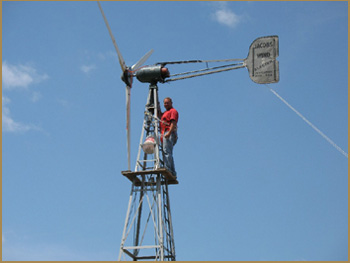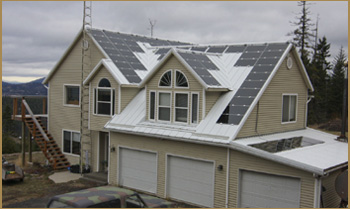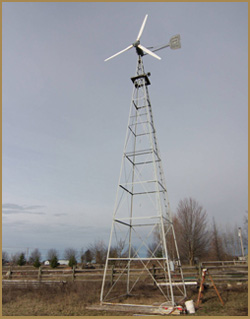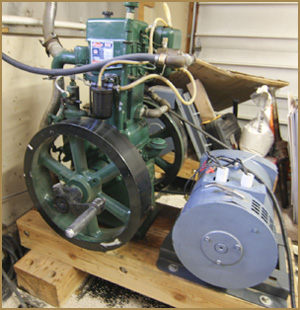 Let’s
divide power into (3) categories, Hydro, Solar & Wind,
and I’ll tell you how well, or not well, that they
work here, in North Idaho. Before we go any further, it’s
worth noting that with ALL power, the primary issue, in
terms of making that power, is how much do you make in
the middle of winter. Creeks freeze, the sun is lower
on the horizon, so it’s generally harder to make
power, when you need it most, in the middle of winter.
It’s the same for any location in the northern hemisphere,
at a higher latitude, as we are in.
Let’s
divide power into (3) categories, Hydro, Solar & Wind,
and I’ll tell you how well, or not well, that they
work here, in North Idaho. Before we go any further, it’s
worth noting that with ALL power, the primary issue, in
terms of making that power, is how much do you make in
the middle of winter. Creeks freeze, the sun is lower
on the horizon, so it’s generally harder to make
power, when you need it most, in the middle of winter.
It’s the same for any location in the northern hemisphere,
at a higher latitude, as we are in.
Hydro-
Hydroelectric Power is power you make through using flowing
water from a spring, creek or river.
While we have a lot of water here, there aren’t
a lot of places that will make reliable, legitimate hydro
power.
Some do exist though, and here is what it takes; elevation
drop, and water flow. Generally, it’s REALLY hard
to get both at the same time.
If a creek is coming down a real steep hillside, whatever
water is behind/above it gets to empty out quickly, leaving
the creek to run dry sometime in early summer. If the
creek is on shallower ground, it may flow slower, and
longer, but it doesn’t have a lot of drop in elevation.
As a rule, smaller properties have a much harder time
figuring out how to make any hydro work, the larger the
parcel, the better chance you have at making legitimate
hydro electric power. I don’t think I’ve seen
more than a couple of properties that are using it year
round, as once winter sets in higher in the mountains,
the spigot of water tends to shut off, just when you need
it most.
IF you can get some hydro, it’s the best thing in
the world, no question, runs 24/7, free power. NOT easy,
though….
 Solar
Power-
Solar
Power-
Solar Power works well in North Idaho, especially if
you buy Thin Film Panels. Ensure that you buy a LOT more
than you think you’ll need, as when the sun is real
low in the sky in December (when you need the power the
most) you’ll be happy for every watt you get. In
summer, you’ll overproduce, but that’s fine.
If you think you’ll need 20 panels, buy 40, you’ll
be really happy you did.
Here is an article I wrote about our solar installation,
I did all of the work, excepting the hookups that required
a certified Electrician. (Link to Article on Solar Install)
 Wind
Power-
Wind
Power-
In North Idaho, unless you are in the Palouse, near the
Washington Border, we really don’t get that much
wind. For example, I have a 50 foot tower with a 3KW Jacobs
Wind Electric Windmill on it, and it makes a lot of power-when
it storms. If there’s a good storm coming through,
my mill works great, but if the wind is getting up to
12 or 15 MPH, I’ll make almost no power.
Here’s why:
ALL Windmills work the same. They all have what is called
a “power curve”, this is a description of where
the power gets made. For example, a typical windmill will
have what is called a “cut in speed”, which
means that it will START making power at that speed, typically
12-14 MPH. Then, there is what is called the “rated
speed” which means that the mill will make it’s
“Rated Power” at, typically between 22 &
30 MPH.
ALL of the real power in any windmill gets made at the
very top of the power curve.
So; let’s say that your mill (rated at 25 MPH, for
full power) is getting 14 MPH of wind, it’s making
no real power.
 Then,
the wind comes up to 20 MPH, it’s now making 23%
of it’s rated power.
Then,
the wind comes up to 20 MPH, it’s now making 23%
of it’s rated power.
Now, wind is doing 22 MPH, pretty close to it’s
rated windspeed….and it’s making 46% of it’s
rated power output.
At 25 MPH, it’s making 100% of it’s rated output.
Bottom line, you need strong, solid winds to make a windmill
pay for itself.
Another note….wintertime/cold weather wind is MUCH
more effective at making power than warm winds in summer.
Colder air is denser air, provides more lift, spins the
blades faster, and better.
Buy a windmill if we find you a nice spot on a hilltop
or something with a south/southwesterly view, and expect
to make good power in winter, when it’s a good snowstorm,
and in spring, when it’s blustery outside. Our winds
here are primarily S/SW, not west or North.
Here’s a link to
the install of our windmill, enjoy!

For any questions or for more information
please email info@revrealty.us